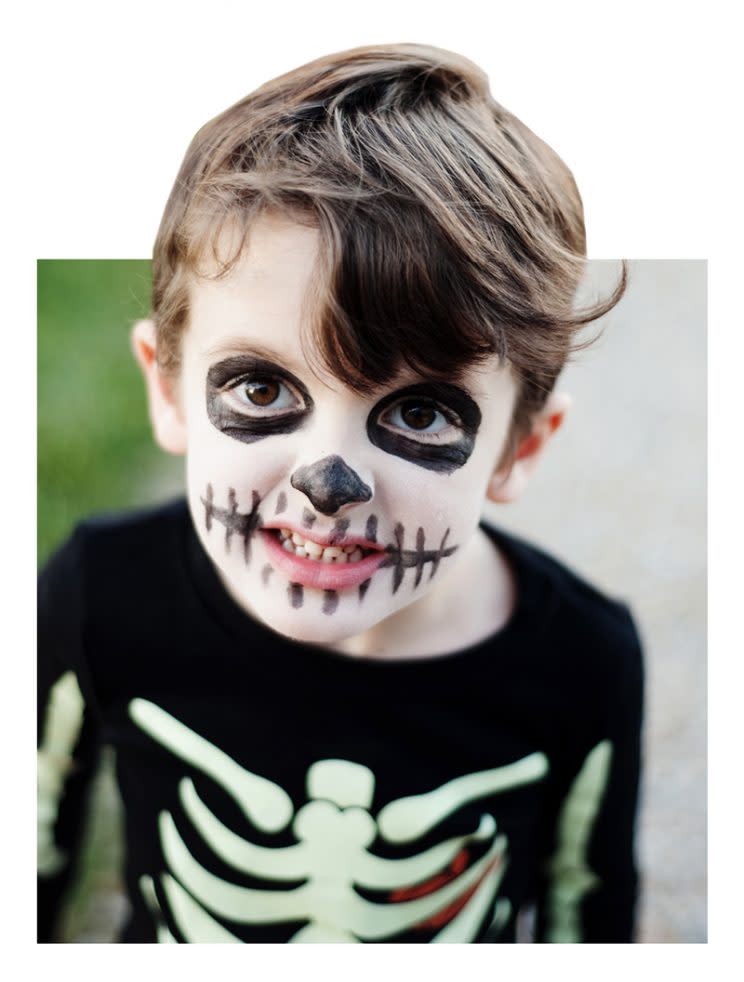Chemicals Linked to Breast Cancer Found in 30 Percent of Halloween Face Paints

A disturbing new report has found potentially harmful chemicals —including possible carcinogens — in face paints commonly used during Halloween. Two of those chemicals have also been linked to breast cancer.
The report comes courtesy of the Breast Cancer Fund (BCF), which sent 48 different Halloween face paints to an independent lab to have them tested for the presence of heavy metals such as arsenic, cadmium, chromium, lead, and mercury. Nearly half the paints had trace amounts of at least one heavy metal, and some contained up to four different ones. Paints with dark pigments were more likely to contain heavy metals — and at high concentrations.
Here’s what the report found, and why it’s so concerning:
Lead and cadmium: No level of lead is considered safe, but lead was found in nearly 20 percent of Halloween face paints tested, and cadmium in 30 percent. Lead is associated with learning disabilities and developmental problems, while cadmium has been linked to breast, kidney, lung, and prostate cancers. When it comes to lead, “the levels were above those allowed in drinking water,” Sharima Rasanayagam, director of science at the BCF, tells Yahoo Beauty.
Ethoxylated ingredients: Nearly 30 percent of the makeup tested contained these. They can create two toxic contaminants that are linked to breast and other cancers: ethylene oxide and 1,4-dioxane.
Toulene: The reproductive toxicant was found in nearly 11 percent of products tested. Toulene exposure has been linked to kidney and liver damage, according to the Occupational Safety and Health Administration.
Parabens: At least one paraben, which is an endocrine-disrupting compound, was found in 34 percent of the makeup samples.
Formaldehyde: A known human carcinogen, formaldehyde was found in 3 percent of products.
Cosmetics are a largely unregulated industry. Although they’re overseen by the Food and Drug Administration (FDA), they’re considered “FDA-regulated,” not “FDA-approved.” That means products don’t have to have FDA approval before going on the market. However, there are certain regulations that apply to them, allowing the FDA to pull a product from shelves if it doesn’t meet the proper regulations.
According to the BCF, children are more vulnerable to the effects of chemicals, and preventing exposure can help prevent health issues later in life. “Many of these metals may have the most profound effects when exposures happen early in life,” says Rasanayagam.
And, she adds, chemicals — like cadmium — that disrupt or mimic hormones are a big concern when exposure occurs during what experts consider “critical periods of development.” “These are times when the body’s own hormones are orchestrating the development of the basic structures and changes in the breast, and they include prenatal development and infancy and the time before and during puberty,” Rasanayagam says.
Before you panic, know this: Scientists haven’t proved that these substances cause breast cancer; they’ve just found a link. That said, Jennifer Haythe, MD, assistant professor of medicine at Columbia University Medical Center, tells Yahoo Beauty that it’s good to be smart about the face paints you use and how often you use them.
“If it’s once for Halloween, that’s probably OK,” she says. “I wouldn’t be using these repeatedly on children, though.”
Danelle Fisher, MD, chair of pediatrics at California’s Providence Saint John’s Health Center, agrees. “Of course it’s really scary and it’s really shocking,” she tells Yahoo Beauty. “We don’t ever think that things that are marketed to kids are going to have bad stuff in it.” However, Fisher says, she’s “a little reassured” by the fact that she’s never seen a child with an overdose of chemicals from face paint or play-based makeup.
But it depends on the dose, she says. “If we’re talking about a child who gets their face painted at a carnival or for trick-or-treating, as long as we follow simple guidelines, we can minimize the exposure of the chemicals.” That includes washing a child’s face thoroughly with soap and water after they use the paint, and being mindful of how often they use it. “If they’re doing it every single day, I’m going to worry about it more than the occasional instance,” Fisher says.
Haythe suggests avoiding face paints that are made in China, where chemicals aren’t regulated as much, and sticking with organic paints whenever possible.
Haythe adds it’s not ideal to use face paint on a baby’s or toddler’s face (their metabolisms are sped up and they can more easily absorb chemicals into their bloodstream), and she recommends keeping any face paint away from the mouth area, where it can easily be swallowed. “The absorption of these chemicals is probably minimal, but everything in moderation,” she says.
If you’re planning to dress up your young kids for Halloween, it’s probably not a bad idea to skip the paint altogether, if you can. “For younger kids who can’t really appreciate that you’re painting their face, dress them up in a mask or put them in a cute costume,” Haythe advises.
Let’s keep in touch! Follow Yahoo Beauty on Facebook, Twitter, Instagram, and Pinterest.

